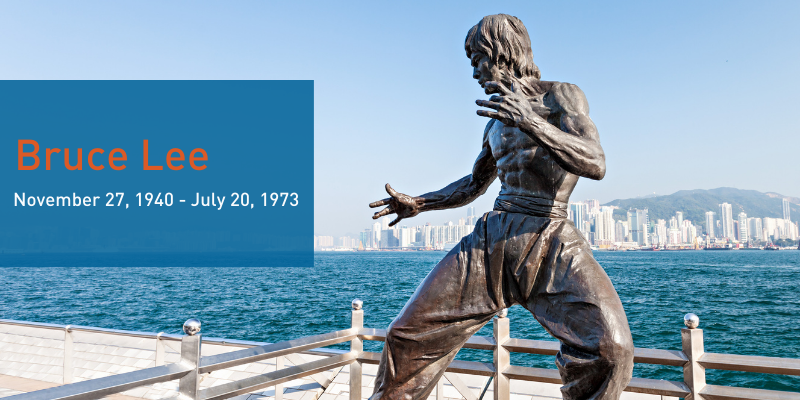| By Gale Staff |
On July 20, 1973, the legendary martial arts master and movie actor, Bruce Lee, died of mysterious circumstances. Just three weeks later, Enter the Dragon premiered in theatres. Lee was the star, and the film’s masterful fight scenes, James Bond-adjacent characters, and indulgent 1970s charms made the movie an instant classic. In fact, in 2004, the Library of Congress selected Enter the Dragon for preservation in the U.S. National Film Registry. Having died at just 32 years old, Lee never had the chance to appreciate his stardom in the West. However, his biography, as well as others, can energize your lesson plans and inspire your students.
This July marks 50 years since Bruce Lee died. To honor the occasion, high school teachers can integrate the resources housed in Gale In Context: Biography to share Lee’s life and accomplishments with their students. Gale In Context: Biography provides well-organized summaries of influential figures from around the world. Users can explore a curated collection of videos, images, magazine articles, and primary source materials from vetted, reliable sources. No matter who your lesson plans feature, Gale’s biographical database will be your new favorite teaching aid!

Learn About Lee’s Early Life
Bruce Lee was born in San Francisco on November 27, 1940. His father, a famous Chinese performer in his own right, brought the family to the United States right before his youngest son was born. However, not long after, the Lees returned to their home in Hong Kong. Because of his father’s connections in the field of entertainment, young Bruce Lee had early exposure to the movie industry and landed several, albeit minor, roles. He was a good-natured troublemaker, indulging in practical jokes but not seeking to cause anyone real harm.
As a teenager, however, Lee’s charisma and temper led him to cross paths with local gang members, so he became determined to learn how to defend himself. He entered the Wing Chun School, a premier martial arts academy. Lee also became an accomplished dancer. No doubt, his strength, combined with physical grace, led to his ultimate success in the world of martial arts. Because of his talents, he continued to earn small roles in the Asian film industry. However, his ongoing association with violent street gangs forced his mother to send Lee back to the United States. Read Bruce Lee’s full biography in Gale In Context: Biography >>
Showcase Lee’s Hard-Earned Accomplishments
Bruce Lee was quickly recognized for his martial arts prowess and acting ability, but it wasn’t until 1966 that he scored his first major role—the Green Hornet’s sidekick, Kato. While Lee’s screen presence was undeniable, there were not many acting opportunities for Asian Americans, and many of those parts were racially offensive or outright degrading. Lee worked hard to pitch ideas and develop respectable work for Asian American performers. But with little success, he did ultimately move his family back to Hong Kong.
Unsurprisingly, Hong Kong viewers immediately recognized Bruce Lee’s star potential. He quickly landed a starring role in Fists of Fury—titled The Big Boss in Hong Kong—and his overall body of work soon defined a new genre in cinema. Lee used his success to create his own production company, an endeavor which later produced his best-known work, Enter the Dragon.
Feature More Asian American Biographies
While Bruce Lee is no doubt an icon, Gale In Context: Biography has hundreds of thousands of biographical entries featuring both contemporary and historical figures. Consider using Gale In Context: Biography’s search filters—including categories like nationality, ethnicity, occupation, gender, and more—to identify other figures whose narratives may share similar themes to Lee’s story.
Jackie Chan is a direct product of Bruce Lee’s hard work and legacy. Chan, now a household name, was born into poverty. His father, a cook, and his mother, a maid, moved to Australia for work when he was just six years old—but they left him behind in Hong Kong, where he was enrolled in the China Drama Academy. After graduating, Chan earned small roles alongside Lee. After Lee’s death, Chan was promoted to the next big screen martial arts master and worked on dozens of cinema products throughout the 80s and 90s. However, despite his talent and unique blend of kung fu and comedy, American viewers weren’t interested in his work. It wasn’t until the movie Rush Hour in 1998 that Chan finally achieved stardom in the United States.
Read Jackie Chan’s full biography with Gale In Context: Biography >>
Ke Huy Quan is another successful Asian American actor, landing roles in blockbuster films including Indiana Jones and the Temple of Doom and The Goonies as a child. But, not unlike Bruce Lee, Quan found few opportunities in U.S. films for those with prominent Asian features. Quan even started going by Jonathan in hopes that the Americanized name would open more acting doors. Nearly 40 years after his acting debut, in a truly remarkable show of patience and perseverance, Quan—no longer going by Jonathan—won the 2023 Academy Award for Best Supporting Actor.
Read Ke Huy Quan’s full biography with Gale In Context: Biography >>
Discuss Diverse Stories in Your Class
Biography as a medium is a valuable tool in any classroom. Reading a story about another person’s life helps us better relate to their personal struggles and accomplishments. Biographies enable readers to more easily step into the shoes of those we see as different, allowing us to develop empathy and challenge preconceived notions about a group of people.
Bruce Lee was a role model for many Asian American actors, inspiring them to achieve success in mainstream American media. To discover even more fascinating and powerful stories for your students, be sure to bring Gale In Context: Biography into your lesson plans.
If your school doesn’t currently subscribe to Gale In Context: Biography, contact your local Gale representative to request a free trial or learn more by visiting our website.

